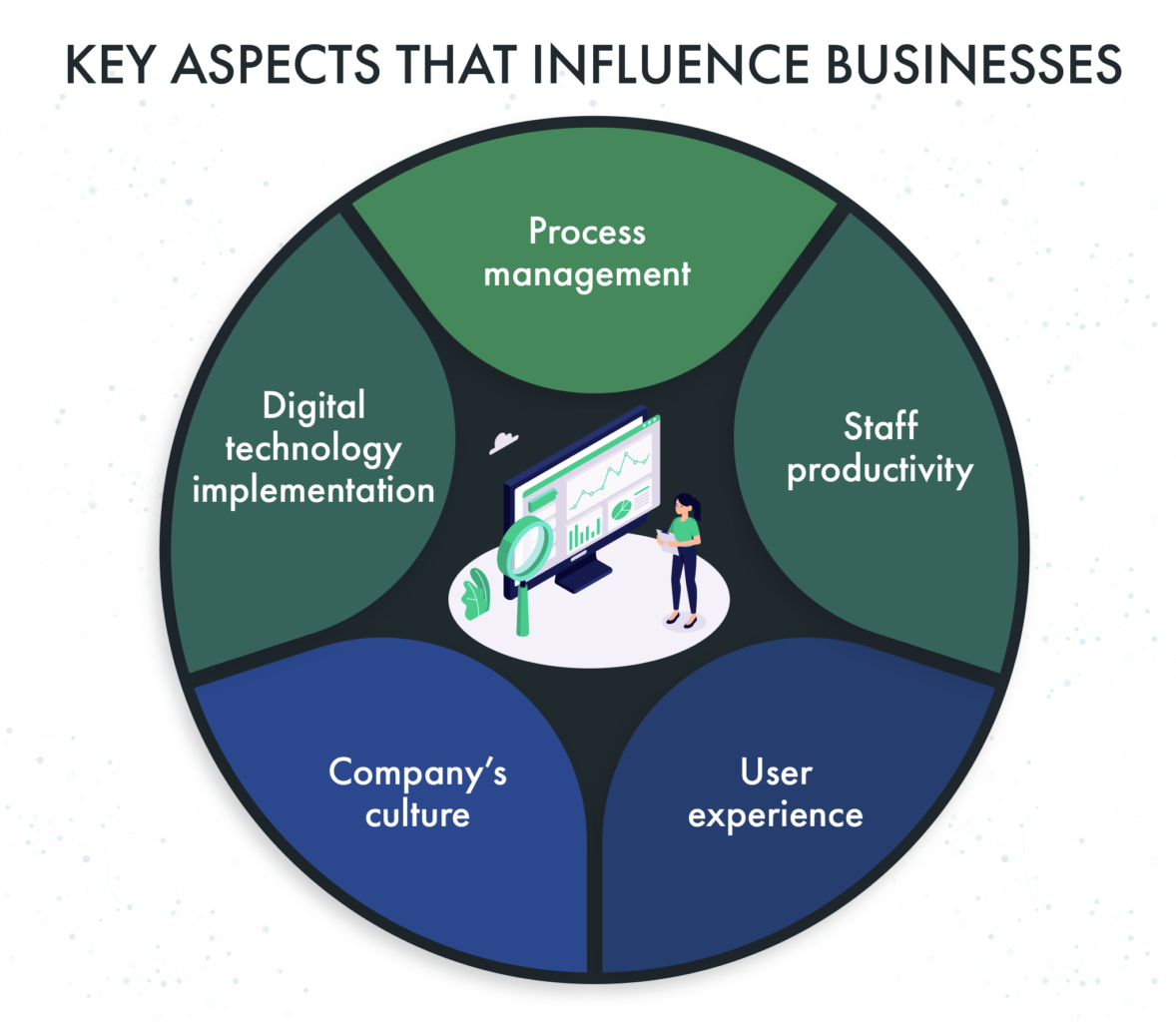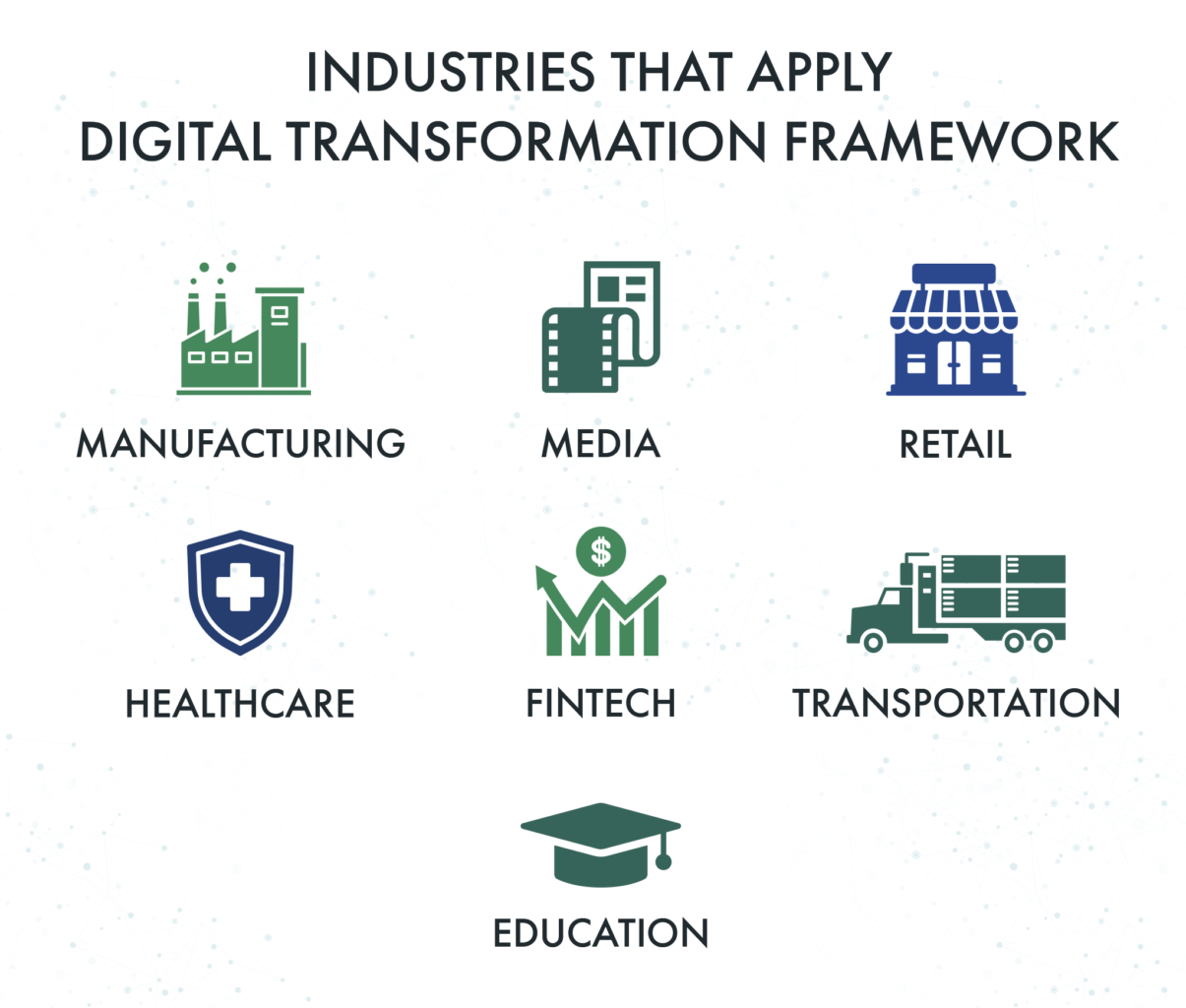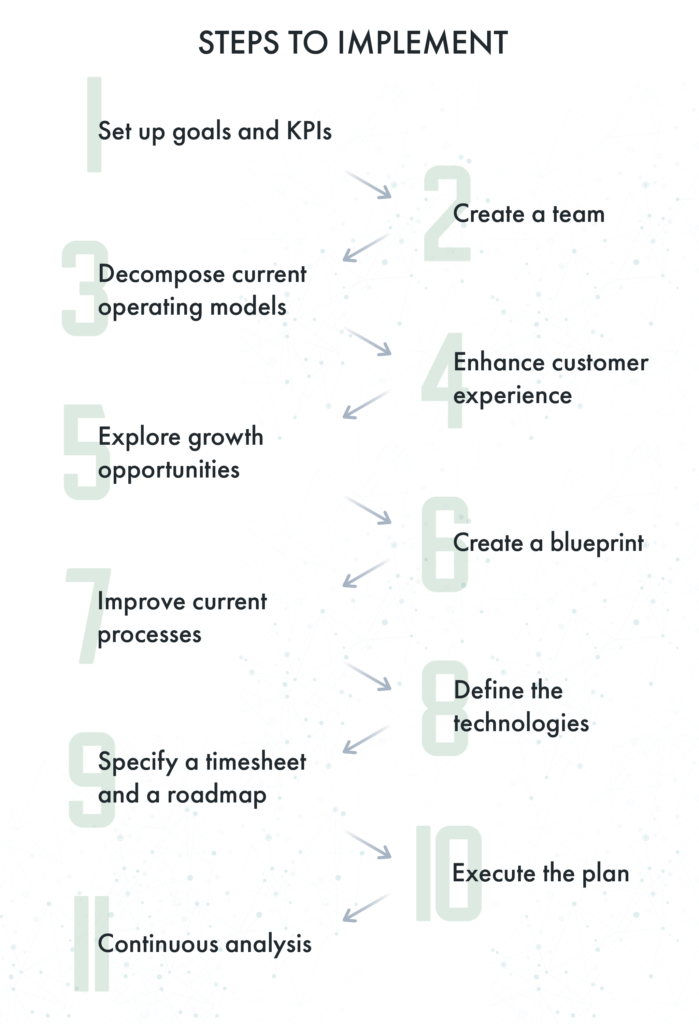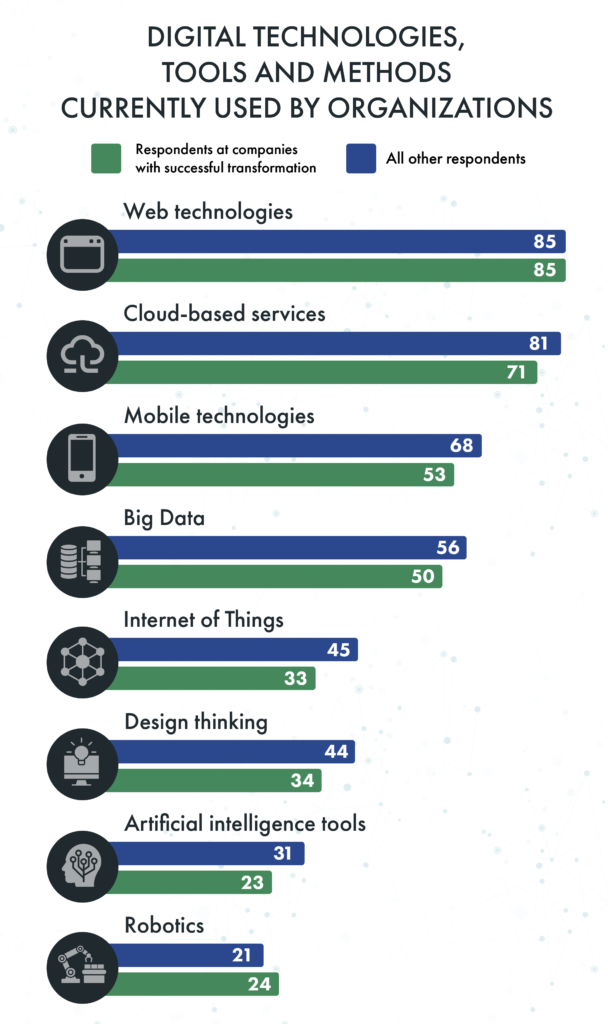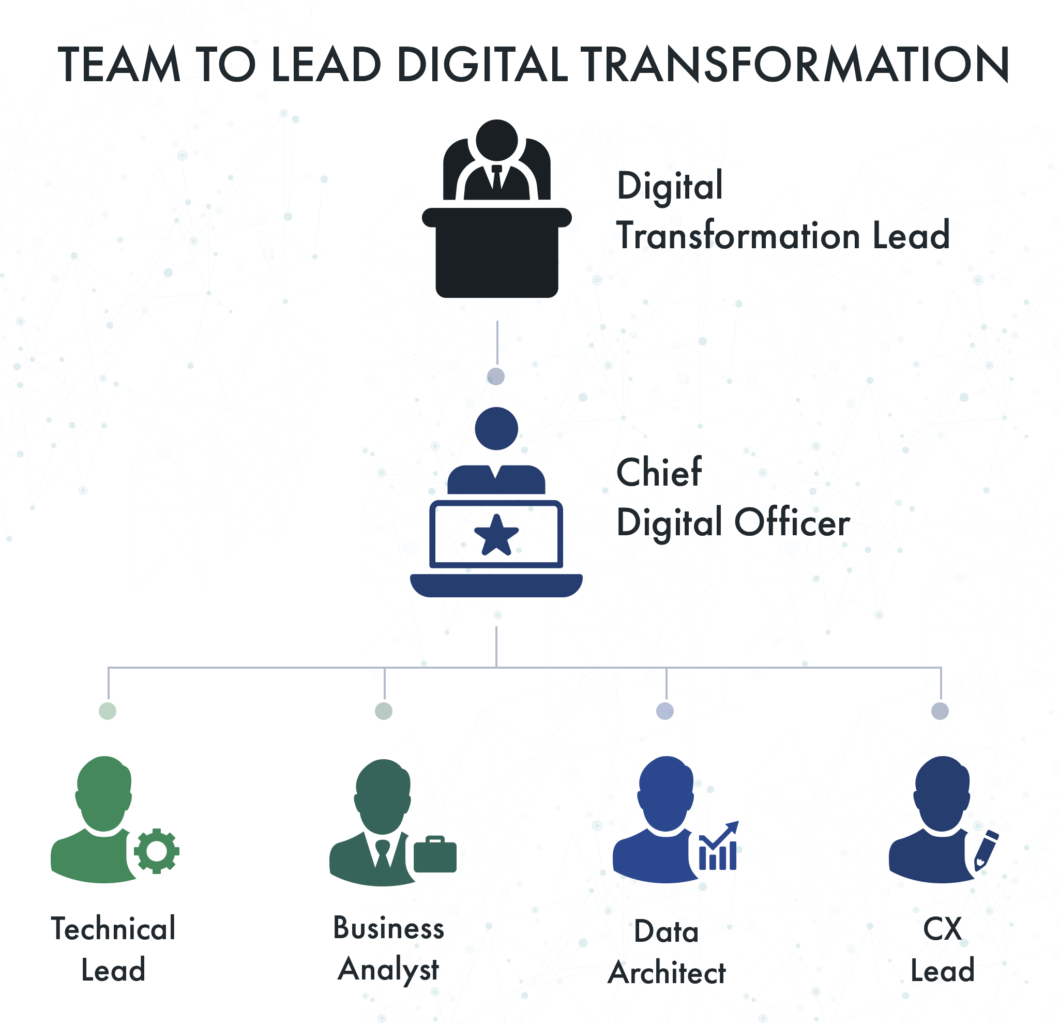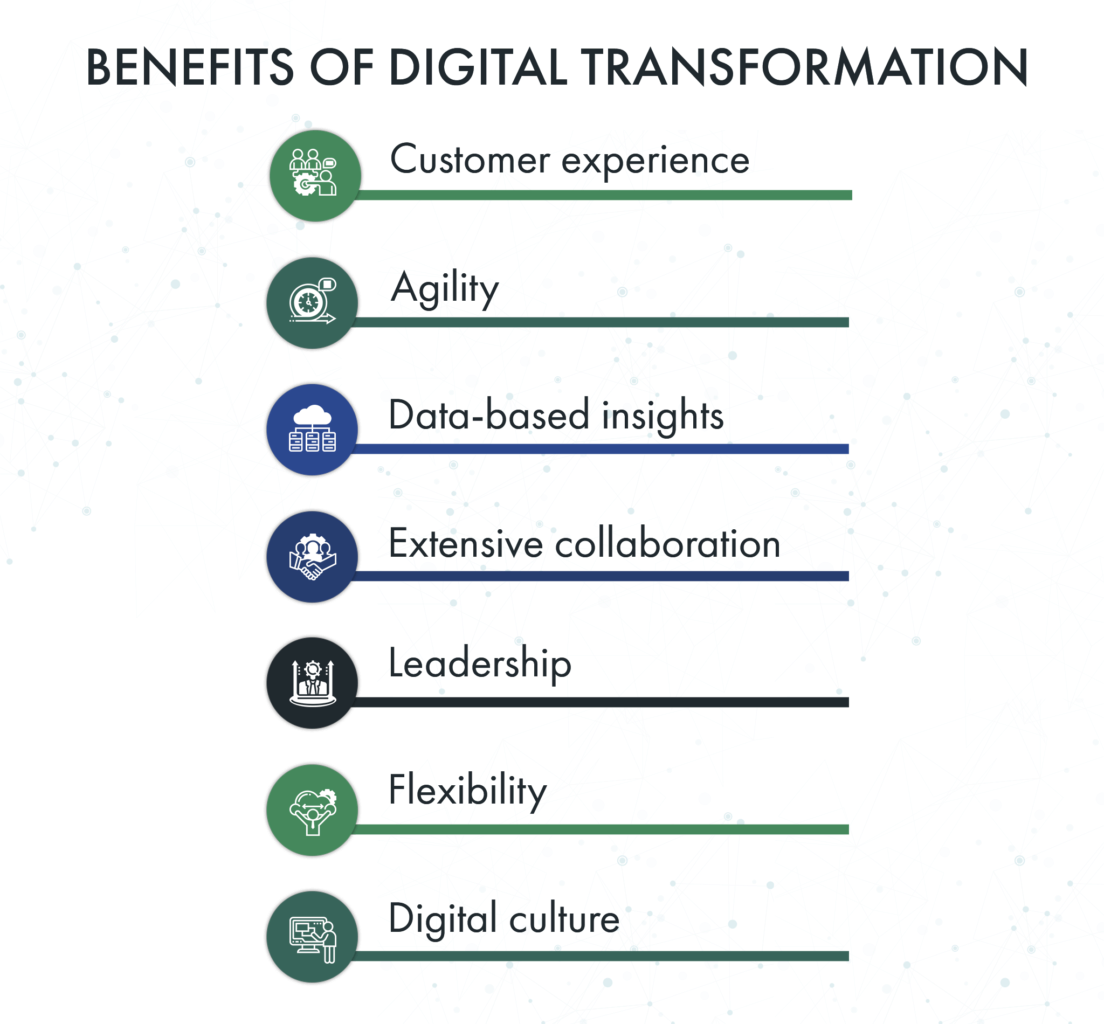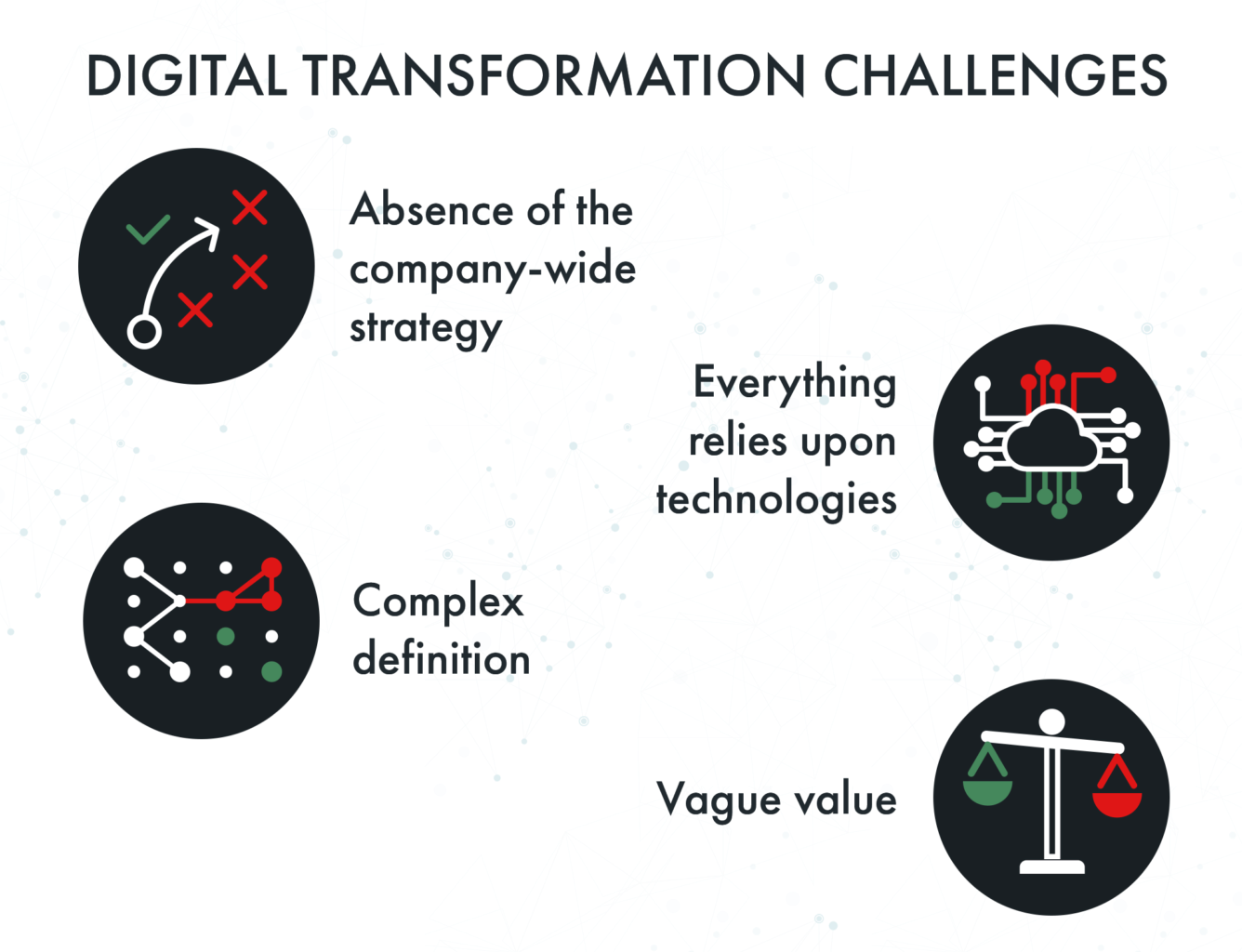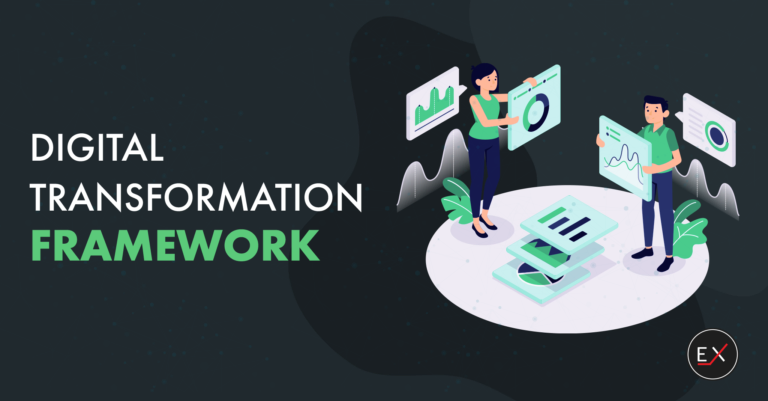
Updated: May 10, 2024
Published: December 18, 2019
It is hard to imagine any business that is working in 2020 without software. They enable modifying the business culture, simplify processes, and improve performance. Technologies focus not only on advancing existing approaches but generating fresh ideas. The efficient digital transformation framework helps to adopt successful transformations. In this article, we’ll discuss how to use the digital framework. Besides, you’ll find out more about digital transformation technologies, benefits, and challenges.
List of the content
- What is a digital transformation framework
- What industries apply business transformation framework
- Digital transformation implementation plan
- Digital transformation technologies
- Team to lead digital transformation
- Digital transformation examples
- Business benefits of digital transformation
- Digital transformation challenges
- In conclusion
WHAT IS A DIGITAL TRANSFORMATION FRAMEWORK
The digital transformation framework is a long-term strategy to enhance the business digitally. It should cover some approaches, technology innovations, and lots of research. That is a complex process of implementing digital transformation technologies. It involves the improvement of existing processes. Also, new solutions can replace them.
Digital Transformation Framework
A plan for replacing or upgrading old workflows and ways of data management leveraging various software.
The digital strategy framework always requires effort, time, and efficient management. Business transformation comprises areas like operational processes, customer experience, and business models. Bringing these aspects into focus allows companies to succeed with different improvements.
- better performance that ensures consistency and efficiency
- business process improvement
- high employees’ productivity
- constant communication across all the business units
- meeting customers’ expectations
- coherent business strategies
That is the era of big data, cloud, APIs, mobile technologies, IoT, artificial intelligence, and machine learning. Surprisingly, less than half of companies have started the digital transformation with the defined programs so far. What’s more, some companies have admitted to being overwhelmed and a bit confused. Why does it happen?
The answer is simple. Organizations that don’t draw attention to tactical planning decrease chances to succeed. It is hard to get changes without a detailed plan.
The digital transformation framework aims at delivering a strategic plan. It would help to integrate the required tools into the current business processes. The company always needs a step-by-step guide through digitization. The digital transformation framework helps to outline business approaches. Companies stay equipped and ready to adapt to the latest trends. It ensures that they consider all areas and not leave some behind. It connects business units and provides efficient results.
Regardless of the company’s specialization, today’s market has outlined specific requirements. Healthy competition, technology innovations, and user expectations drive the market needs. Applying the digital transformation framework is a great solution. Companies get a powerful tool to make the right changes. They can predict future needs and keep pace with different trends.
Any industry wants to deliver up-to-date and high-quality services. It also remains the main subject of the digital strategy methodology. So there will be no exceptions here. They receive efficient solutions to manage daily processes, tool changes and take opportunities. There are several key aspects that matter for each business.
- User experience: Fulfillment of user needs provides a positive customer experience. It helps to keep customers loyal to your organization, services, and products.
- Process management: Changes need some efficient tools to streamline daily processes. It is a great way to establish communication and collaboration on all the levels of the business.
- Staff productivity: A digital framework also affects the productivity of the staff. It boosts performance, streamlines routine work, and shows new areas of improvement.
- The company’s culture: Consistency helps to develop great relationships. Get engaged with both your employees and customers. It forms the basis for shared business values, attitudes, norms, and goals.
- Digital technology implementation: The well-outlined strategy is a must-have here. Thus, digital transformation technologies allow businesses to cover all the necessary needs.
WHAT INDUSTRIES APPLY BUSINESS TRANSFORMATION FRAMEWORK
The digital transformation framework is an excellent opportunity to strengthen business positions. Companies can choose different tech approaches. Yet, they need to come up with the right implementation plan. Despite the industry specification, it covers similar goals. Efficient improvements provide considerable business benefits of digital transformation.
Industries are eager to adopt a digital business transformation framework. It allows them to strengthen their market positions. Let’s consider some of the leading industries here.
Media
This industry is changing rapidly. Media companies have to find new ways for contextualization and personalization. They work on content delivery using the latest tech innovations. Mobile and social extension transforms the media inevitably. This industry draws much attention to real-time content management. Instant access anytime and anywhere is one of the main goals. Constant insights across different channels and data analytics support the relevant user experience.
Retail
Dynamic approaches are in much demand among retailers. Thus, the efficient digital transformation strategy framework can outline new ideas for automation. The fastly-growing eCommerce industry is full of the latest innovations. Customers are already used to chatbots, voice assistants, eWallets. Moreover, digital transformation tools offer vast potential for brick and mortar stores. For example, IoT technology helps to improve in-store management and optimize product placement. It is a good idea to leverage predictive analytics. It becomes easier to personalize customer experiences in both physical and online shops.
Manufacturing
The technological revolution has dramatically influenced the manufacturing industry. Innovations have gone a long way: computer-aided manufacturing, big data, IoT, cloud computing. Manufacturers manage to improve productivity. Thus, they ensure production efficiency and increase profitability. Automated processes allow them to deliver products within the shortest timeframes. It leads to better business opportunities.
Healthcare
The digital transformation framework has a broad practice among healthcare providers. This industry is undergoing rapid changes driven by tech trends. With AI incorporation, medical practitioners get help with making diagnosis and surgery assistance. Patients can receive quality remote care through telemedicine. The recent trend – the Internet of Medical Things (IoMT) encourages the usages of wearables. Thus it advances the patient experience and new ways of providing care. Another thing is the security of healthcare data. Advanced technology approaches allow storage, exchange, and process it within all compliance regulations.
Fintech
New customer interaction models need the adoption of digital transformation tools. The Fintech industry supports user trust, safe data storage, and exceptional financial services. More and more banks start to switch to digital banking. Such technologies as AI and blockchain provide excellent solutions for them. Many companies decide to leverage blockchain databases for their projects. They can overcome outdated approaches and pursue security strategies. Financial providers also draw their attention to working with big data. It supports client-focused practices and maintains data security.
Transportation
The technological revolution has dramatically influenced the manufacturing industry. Following the latest innovations, it has gone a long way. Computer-aided manufacturing, big data, IoT, cloud computing. Manufacturers manage to improve productivity. Thus, they ensure production efficiency and increase profitability. Automated processes allow them to deliver products within the shortest timeframes. It leads to better business opportunities.
Education
Educational institutions feel the necessity of a digital transformation framework. It has become a big challenge for this industry in light of the current situation. Though, they are fast with adopting the digital transformation implementation plan. For example, virtual and augmented realities can bridge the physical and digital worlds. eLearning integrations can unify the essential interactions between teachers, students, and educational institutions.
What companies need to apply a digital transformation framework?
Despite the industry specification, every company has to come up with a digital transformation framework. It is a must-have to go through digitization successfully and strengthen your market positions.
DIGITAL TRANSFORMATION IMPLEMENTATION PLAN
Leveraging our experience across different industries, we’ve compiled a list of implementation steps. Corporate digital transformation is a long-term process that requires planning and insights. Companies can spend years putting it into practice.
Initial business ideas are thoroughly analyzed and continuously improved. It helps to define the reasonable approaches across all business units. Following simple digitization guidance can result in complementary sequences. This guide provides you with tips on implementing a successful digital strategy framework.
Set up goals to work out a transformation strategy
The digital transformation framework outlines long-term perspectives. It improves the company’s processes, changes business environments, and enhances customer experiences. So, innovative business models enable effective task prioritization. All the improvements are completed step by step since tasks are explicitly targeted. A good idea is to set both short-term and long-term goals. Companies work towards similar goals like an increase in sales, customer engagement, better staff performance. Yet, it is great to stay more specific and define your goals in the following ways, for example:
- provide clients with new ways of interacting with your business
- increase sales up to 30%
- increase the recurring sales rate by 25% in 12 months
- get the maximum use of your data to gain insights into the target audience’s preferences
Organizations that gain detailed insight are faster to put changes in place within digital transformation services.
Assemble a digital transformation team
Don’t underestimate the role of a digital transformation team. Digital transformation requires an enormous amount of work for the team over an extended period. You need to assemble a group of stakeholders. Being responsible for one specific part of the business, they have a deep understanding of the domain. The digital transformation lead is the person who manages the digital transformation team. The knowledge about each chain of the organization allows him to see the big picture at the same time to define a general strategy.
The cross-functional team adopts new operating models and guides the company through digitization. You can either assemble the in-house digital transformation team or hire an external service provider. In both cases, you manage digital business transformation and seize unique opportunities. As for the team composition, we’ll consider it in a separate paragraph.
Decompose current operating models
Digital business transformation is way more than just making processes paperless. It has to fulfill business purposes. By decomposing current workflows and data management processes, companies have great opportunities for advancements. It encourages positive business environments, efficient interactions with customers, and continuous communication within your organization. It is an excellent foundation to ensure staff productivity and user satisfaction.
Break down all your workflows into steps and think of how the software can be organically implemented to enhance every step. Your field force workers get the paper list of orders to perform daily work. And you have a person responsible for calling them if the schedule is changed? It requires a lot of time and leaves space for human error. Provide them with a web portal where the orders are updated in real-time and allocate your resources effectively. That is how digital transformation will allow you to perform more orders daily and thus earn more money.
Enhance customer experience
Companies also have to rethink the way they interact with clients. It is quite essential to get your customers involved. Data-driven marketing has dramatically changed the relationship between customers and companies. Digital channels have supported new ways to do business and keep in touch. Good connections and customer feedback will provide fresh ideas for improvements. Web and mobile presence have already become standard practice.
One of the most noticeable examples of how digital transformation has drastically changed the industry is banking. When the client needed to call a bank to check the balance was long past thanks to the ATMs, then SMS services, and now – mobile apps. Banking applications completely changed the way people interact with their banks and finances. The best mobile applications encompass the full set of financial services on your phone. Clients can literally never visit the physical offices, and completely digital banks are becoming new. It is safe to say that 9 out of 10 people would choose a bank with a convenient mobile app over another one. Even if the transaction commission will be 20% higher. In the context of digital transformation and customer experience – banks have found a new way to interact with their clients. This increased customer satisfaction rate, allowed them to save on the workforce and skyrocketed the number of transactions. Simply because those transactions became easier to perform; moreover, it brought new channels of income. People just call each other and ask to borrow some money via sending them to the account. Needless to say, banks earn their commission on such transactions. While previously, people used to lend money to a friend in cash, which omits any bank interest.
Explore growth opportunities
The next step is to find different ways of advancing the business. Make sure to explore market opportunities. Rethink how to manage the internal processes. Find new channels to interact with customers. The digitally-enhanced company will adjust connectivity across all the business areas. Lacking these connections reduces chances to explore new business ideas. Growth opportunities arise frequently. Classic strategies supported by new approaches will ensure the smart plan execution.
Create a blueprint for changing business environments
Companies have to structure innovation processes. It shows how it is going to influence your business models. The detailed plan foresees how current internal workflows and customer interactions can be done with software or any other tech solution. It makes projections about business expectations and areas for improvements. A step-by-step guide provides you with data to base future judgments and choose the methods of implementing your goals.
Conduct a detailed analysis of improving current processes
The careful market examination provides valuable insights into building a digital transformation business framework. Analyze the current software and tech market offerings. Learn from your competitors. Consider the best market practices. That allows you to see how processes can be enhanced, what tasks can be automated or omitted, and what data can be collected or used. Realistic expectations are possible due to analyzing the data from all business fields. It ensures continuous work on efficient product and service delivery.
Software that you’re going to use to enhance the old business process regularly has additional features. Those features are brought by the accumulated experience and requirements of other users from various industries and businesses. Simply doing the same things as before but faster and better is a digital transformation in and out itself. But new software adds an extra value. Thus, the digital transformation team should carefully examine it to identify opportunities for further enhancements.
The same goes for workflows and data management. Recreating old is good enough. But transforming your existing workflows, for instance, to omit some steps or tasks, will bring even more value.
Define the required technology
With current technology market offerings, companies can take so many opportunities.
- Web technologies
- Cloud-based services
- Mobile technologies
- Innovative design
- Big Data
- Internet of Things
- Robotics
- Artificial intelligence
- Virtual reality and augmented reality
- Additive manufacturing
The choice is excellent. Yet, the final decision is driven by the internal company’s needs. Starting with any of these technologies has to address specific business goals. Also, take into account rapidly changing customers’ expectations. It would help if you kept pace with market trends. Digital transformation technologies are a powerful tool to put your ideas into practice. The main goal is to guarantee technology functioning along with the business side. It will unify operating models, support scalability, and drive a digital transformation execution.
Define a timesheet and roadmap with the KPIs
Besides the review of business objectives, it is always essential to use a clear roadmap with timelines. Companies need to be rather specific here. KPIs help to measure your targets and improve performance. They provide the focus for both operational and strategic improvements in fixed terms. Moreover, useful KPIs draw attention to something that matters for the business. It can include revenue growth, customer engagement level, etc.
In later stages of the plan development, it should include things like what software should be implemented and for which business units, how those applications will be interconnected, what the data structure will look like, etc.
Execute the plan
The roadmap helps to divide a digital transformation framework into separate stages. That covers precise details on its implementation. Thus it allows companies to choose the right combination of approaches to execute the plan. Yet, the organization should be ready to change the initiatives if required. Forming the right business strategy, you can predict different options but choose the best one. The agile approach helps to keep businesses flexible and adaptive. It delivers operational effectiveness and decreases the level of risks.
Considering the eCommerce example, it is worth mentioning how far the industry has gone. They have not only provided the ability to purchase the product whenever customers want. But it became way faster and easier to complete these orders. Retailers worked on improvements in internal processes. For instance, they manage, streamline, and integrate all essential processes within the custom CRM software. Thanks to integration tracking and constant reports, retailers are provided with new insights to lead their marketing strategies. It results in better customer engagement and higher revenues.
Continuous analysis
Data-driven insights outline necessary contributions for business development. It carefully guides the organization along with the complex digitization integration. The received results allow companies to increase productivity, reduce expenses, generate higher revenues. Comprehensive analysis is always a significant extension of technology trends. Businesses that want to succeed have to maintain growth.
Going to implement digital transformation?
Get in touch with our team to get a professional consultation and find the solution due to your needs.
DIGITAL TRANSFORMATION TECHNOLOGIES
The adoption of innovations is an inevitable part of the digital strategy framework. The broad suite of technologies opens vast possibilities for organizations. It is often stated that the more technologies to apply, the better results the company gets.
Though its execution has to be carefully planned and meet the company’s needs. The right combination of digital transformation tools plays a vital role. You need to assign the whole team to lead the digital transformation framework. It is not only about technical experts. They always collaborate with other professionals. It is vital to avoid complex execution and find reasonable solutions.
Considering the market tendencies, there’s a list of the most popular digital transformation technologies.
Custom/ Off-the-Shelf Software Products
Digital business transformation starts with enhancing or even replacing the ordinary workflows. That is commonly implemented by means of different software products. Companies can either build custom solutions or purchase the ready-to-use software. Chosen tools have to correspond to the organization’s initiatives and specific business units. For example, accounting software is vital for any business, but it can be more efficient if integrated with your CRM or ERP systems. Here are some of the commonly used software:
- Web Applications
- Collaboration tools (Slack, Zoom)
- Project Management Tools
- ERP Systems
- CRM
- DMS
- CMS
- Accounting
- Supply chain/ stock management/ warehouse management tools
- Big data
- Etc.
Cloud Platforms
Cloud computing carries out the main advantage of connecting business anywhere and anytime. It makes data access easy and convenient. Cloud-based services help to manage and maintain different systems and user applications. It is where you run your cloud apps, host mobile applications, or store data in the cloud. Thus, it ensures data protection and minimizes risks of data loss. These digital transformation services are the perfect solution to support your business continuity. Check the list of the most popular and trusted cloud services providers
- AWS
- Azure
- Google Cloud
- Heroku
Customer-Facing Applications
Besides internal workflows, you need to find an efficient way to engage with customers. In this category, we brought examples of the solutions you can give to your clients to interact with your services and products. Today’s market is driven by convenience and mobility. Moreover, it is important to support interaction across different channels. Bringing back the previous example of the banking industry, digital transformation tools can be classified into two main kinds: for internal and external use. For instance, a paperless document management system implemented for documents management between bank’s departments – is purely for internal use. Mobile app, in turn, designed for bank’s clients, which means it is a customer-facing product.
- Mobile apps
- eCommerce
- Customer web apps/ portals
- AR/ MR/ VR
- Etc.
Artificial Intelligence
The advancement of AI technologies makes it possible to handle significant and complicated tasks. As an example, we can consider the following use cases – medical diagnosis, predictive maintenance, product recommendation, image recognition. Moreover, it manages to expand human creativity as they find free time for innovative features. AI covers such fields as
- Machine Learning
- Deep Learning
- Neural Networks
- NLP
- Computer Vision
Robotics
Many industries have acknowledged the full benefit of using robotics. It can improve the speed and consistency of operational processes. Besides, robots tend to deliver better quality and eliminate human errors. They are good at precise and repetitive tasks. Again, you can delegate dangerous work to avoid human injuries. Those tasks can be handled with the help of
- Intelligent machines
- Robots
Additive Manufacturing Technology
Additive manufacturing has enabled digital flexibility and efficiency for manufacturing operations. As a result, this approach is also known for its subsets like 3D printing or rapid prototyping. Once impossible concepts or designs become subjects of successful reimagination and modeling. Moreover, parts production carries out a promising advancement in healthcare, aerospace, and automotive. Here are some of the common examples:
- Sintering
- Direct Metal Laser Sintering
- Direct Metal Laser Melting and Electron Beam Melting
- Stereolithography
Internet of Things
IoT creates a smart environment for humans, machines, and digital devices. It transmits and shares data across the built network without extra interactions. IoT improves monitoring, operation control, and interactions. Companies often apply:
- Hardware (sensors, wearable electronics, standard devices)
- Software (data collection, device integration, real-time analytics)
- Technologies (Bluetooth, RFID, NFC, WiFi, ZigBee, Thread, LTE)
Have some questions?
Feel free to contact our team for additional information. Get expert consultation on digital transformation technologies.
TEAM TO LEAD DIGITAL TRANSFORMATION
To lead a digital framework within the organization, you’ll need to set up a cross-functional team. Transformation efficiency depends on team productivity and functionality. They are the ones to develop the digital strategy framework and guide the company through it. The team should consist of specialists with different expertise. But they should be capable of collaborating all the way along.
Before we go through the list of specialists, we need to define some general requirements. All the team members need to have considerable skills to ensure:
- Effective teamwork
- Open communication
- Adaptability and flexibility
- Leadership
- Strong work ethic
Another thing to consider is collaboration and communication with all involved parties. The team structure aims at establishing necessary links with administration, employees, customers, partners. Also, the team exploits involvement capabilities to reorganize business processes and models. The transformation team carries out a blend of technology, business, and management expertise. Considering the team obligations, it should consist of such experts as:
Digital Transformation Lead
Companies will support any transformations at the executive level. The primary change player role goes to the CEO. His duties include establishing alignment at all levels of the business. Though leading the digital business transformation framework is usually assigned to some of the senior executives, for example, the COO. One more option is to hire an individual specialist that focuses on digital business transformation, particularly. In both cases, the digital transformation lead encourages changes, manages the process, and embraces arising challenges.
Chief Digital Officer
That is a relatively new position in the business. Though its necessity evolves extremely fast. The chief digital officer is the cross-functional change executive to ensure collaboration inside. The key responsibilities are about setting and implementing a digital transformation framework. In short, this team member drives and controls every digitization strategy framework step. The CDO builds, manages, and contributes to the strategy. They work on both internal and external improvements.
Technical Lead
The technical engineers handle the technical part of the digital strategy methodology. They are ready to suggest the greatest technology solutions to meet the company’s needs. Best practices and promotion of the latest tech trends can make a big difference to the business. Moreover, they will be able to set up the right team to reach those changes.
Business Analyst
Gathering and preparing business requirements is an essential step in the digitization process. The business analyst is responsible for business process modeling. They define the company’s policies and procedures. Also, take up changes requests and perform acceptance testing. The business analysts support the transformations with the elaboration of the smallest details.
Data Architect
The data architect sets the vision for the usage of the organization’s data. It is rather vital to oversee the data design in different models. Thus it is easier to meet the business needs and define the right data strategy. It helps to manage the data product life cycle and come up with efficient data architecture.
CX Lead
Customer experience lead designs the lifecycle of the company’s product. They define the main principles of how to establish interactions with customers. They monitor all the processes that have direct contact with the customers via emails, calls, web, or mobile apps. CX lead is responsible for creating the interconnected and seamless client’s experience across all the digital tools at the company’s disposal. The duties include the service review from the client perspective. Evaluation of customer feedback allows them to identify the real needs and necessary areas of improvement.
We’ve named some of the prominent roles to lead a digitization framework. But companies could extend the team with more members. Separate departments can handle technical or financial parts of a digital strategy framework.
DIGITAL TRANSFORMATION EXAMPLES
Many companies can share success stories about utilizing digital transformation tools. Thus, any industry could accept the evolution within the digital strategy framework. Digitization is growing in popularity.
That turns to be the primary key to withstand the changing market requirements. There are so many options to accept the digitization strategy framework. You can always learn from best practices across the market. It is excellent to advance user experience and provide exceptional services.
Nike
For instance, the shopping experience has dramatically changed over the last decade. Physical stores are vital for retail. However, many sales transactions occur online. These are market platforms, eCommerce websites, and mobile applications. The retail industry has acknowledged high traffic rates and increased revenues. So going online isn’t enough. Retailers need to offer some extra features and services. That is what differentiates market leaders.
Nike has focused attention on data analytics to bond strong connections with customers. They managed to build a strong foundation for efficient marketing campaigns. For example, there is the Nike+ program with better opportunities for loyal customers. Personalized engagement with clients is another thing to emphasize. The company has a mobile app that can scan the feet and choose the best type of shoe for each customer. At the same time, this data is used to produce better footwear in the future.
Pfitzer Inc.
The pharma industry is another example of a currently performed digital business transformation framework. Companies favor new ways of producing and marketing. Besides, they support scientists to create effective drugs and vaccines. Their focus is on scientific evaluation that can change patients’ lives.
Pfitzer Inc. knows how to lead a digital transformation framework. They collaborate with clinics and patients to digitize their interactions in clinical trials. Their Centre of Excellence of analytics often gathers awards as the industry leader. Clinical research and health data pools enable producing more effective drugs. The company applies secure and innovative ways to digitize patients and personnel experiences. They always consider patients’ preferences on use and access to health records.
Capital One
Customers’ expectations can make significant differences in businesses. We can mention banks and how their operations are organized for customers. Self-service points, mobile applications, authentication solutions, cashless payment systems. Users can conduct most bank transactions via the web. It takes a few clicks to pay bills or send funds to family and friends. It is rather popular to use payment gateway services like Apple Pay, PayPal. Customers can link accounts directly to their devices—no need for cash or plastic cards.
Capital One was the first one among financial providers to adopt a digital transformation framework. They are open to innovations and ready to set their trends. No surprise, they were first to adopt Amazon’s Alexa virtual assistant. As well as support Apple’s Touch ID biometric software in banking services. They value their customer experience and do their best to advance it. The Capital One Impact Initiative targets to improve socioeconomic mobility. The company spends $200 million to support economic growth across low-income communities. Also, the bank’s clients favor the initiative of opening Capital One Cafes. There they can receive free money management sessions, talk to financial coaches, visit workshops, and of course, enjoy a cup of coffee.
BUSINESS BENEFITS OF DIGITAL TRANSFORMATION FRAMEWORK
A digital transformation framework enables joining all business’ areas into one powerful mechanism. It outlines the required strategies to lead the company through various innovations. The number of digital transformation benefits is impressive.
It comprises team functionality, digital transformation technologies, user needs, and market requirements. It helps to make positive changes to the current business situation and support it with top-level services.
Customer experience
Today’s customers are looking for reasonable and fast solutions. We can consider integrating the food ordering apps to the delivery services for the past five years. They can efficiently process most orders online. Clients don’t need to spend time on the phone conversation with the human operator to learn the menu and order. Another positive point is the possibility to keep in touch with your audience. Push notifications can be a good sample. Customers will stay informed about new offers, various deals, discounts, etc.
Agility
Adopting changes is a continuous process that never ends. As a result, companies can develop consistent strategies. You can strengthen a position and improve fast within the business transformation framework. Most services are now automated in both private and government institutions.
For instance, citizens don’t need to go to the state organization. Their request can be processed and transferred from one department to another automatically. Paperwork is being replaced, as tons of data are stored in the cloud. Moreover, everything remains structured, and the possibility of losing some data is decreased to a minimum.
Data-based insights
Detailed data analysis supports transformations. Such insights are vital for making decisions as they are related to process and strategy optimization. Well-organized workflows are an excellent solution for any company.
For example, it is much easier to perform sales and enhance marketing strategy. Many organizations apply ERP modules. They use separate modules for sales, marketing, distribution, purchasing, logistics, warehousing, inventory, etc.
Extensive collaboration
Collaboration in the company always remains the key priority. Yet, it isn’t that easy to establish it across all the levels. The digital era has offered many tools. You can structure, process, and share the data in a few clicks.
We can observe a lot of changes to the organization of workplaces.
Collaboration apps, cloud platforms, CRMs will boost business efficiency and employees’ productivity. The adoption of virtual and augmented reality enables the options to work remotely. You can have online meetings and collaborate with the team members from any location.
Leadership
This advantage concerns the analytic and strategic approach to the transformation process. The digitization framework serves as a template for fulfilling the organization’s goals. Also, it could define risks in advance.
For instance, the steps of the distribution company depend on prior experience. Taking into account the received results, they can easily find out what products are popular among customers. Also, if they need additional advertising or what amount of goods need to be produced.
Flexibility
That includes the ability to stay up-to-date. Keeping up with trends isn’t enough. The organization has to face and overcome the appearing challenges. To achieve desirable results, always be ready for constant improvement. Implementing the mobile application might not be enough in some time.
The company should continuously support updates and add new features. Like in eCommerce, you can always add new features. These are payment and delivery options, scheduled orders, e-gift cards, tracking, etc.
Digital culture
One more positive aspect is developing an innovative culture at all company’s levels. It should produce an adaptable atmosphere, robust connections, and productive workflows. The digital transformation framework handles communication and collaboration within it. Both employees’ and customers’ engagement is a unique benefit to success.
The taxi services that have a mobile app for customers should provide separate ones for drivers and administration. Thus the drivers can instantly accept and perform orders. Simultaneously, the administration dashboards receive any other details like payment or customer feedback. Digital culture has to be established on every level. Employees’ engagement, good management, and shared values will always bring impressive results.
DIGITAL TRANSFORMATION CHALLENGES
Implementation of the digital transformation framework is worth the effort. However, it isn’t a quick and easy process. We want to mention some common myths that might mislead companies. Or even turn their back on continuing digital transformation. A successful digitization strategy framework is also about getting ready to face challenges. Businesses have to be aware of the following issues and find effective ways to overcome them.
Absence of a unified strategy across the company
Various software started to appear on the market more than 40 years ago, long before the concept and term “digital transformation” has been shaped. Naturally, many business divisions started to adopt new technologies and software products earlier than the rest. This is especially true for large companies. For example, warehouse management solutions started to appear much earlier than the eCommerce solutions for online shops and storage management products. The result is a division between software age, APIs, integration options, etc. This even depends on the department head’s personality because the implementation of new software products often depends on the management’s initiative and willingness to leverage new tools.
So, in 2021, the digital transformation team almost never faces the challenge of transition from analog workflows with old-fashioned paper documents and data records. Instead, they deal with the spaghetti of digital data formats and software solutions that are badly interconnected and didn’t age well.
The digital transformation framework doesn’t suit only specific departments. As well as you can’t just consider the needs of a particular user group. These are some of the common mistakes. The whole concept depends on the combination of
- requirements;
- tech approaches;
- continuous research across all business areas.
Applying a digital strategy framework in one department won’t guarantee improvements everywhere. It becomes effective within a combination of changes in each business part. The company-wide strategy oversees step by step implementation. It might take time to make changes in some business units. Thus, it is not left aside but planned for later. The right digital business framework always relies on a comprehensive strategy.
Everything relies on technologies
That is one of the misleading concepts. It makes the company believe that adding cutting-edge tools completes the overall transformations. Beyond any doubt, technology is an indispensable part of the process. However, it has to be accompanied by marketing strategies and data-based insights. After all, the software is just a tool, and it is up to the company’s leadership on how to apply it.
It is essential to practice the digital culture within the organization.
Effective utilization depends on subsequent and analytical tool integration. It covers all the existing business processes within the digital framework. Thus it allows tight and continuous collaboration between technical and business experts. The extended team helps to define the most appropriate digital transformation technologies.
Complex definition
Technology integration is a complex long-term business process. The digital transformation strategy framework should present a detailed implementation plan. However, not everyone accepts the situations when it needs to be improved or changed. It might just seem like a step back. At the same time, the company needs to avert those challenges and grow the potential from it.
You can’t oversee every small detail at the beginning. But you need to get the most digital transformation benefits out of it during the process.
Vague value
There is a wrong belief. Observing no clear or significant value requires immediate actions. And even worse – frequent rejection of the initial idea. Take into account that digital transformations aren’t done in one day. So evaluating all the results should be divided into separate stages.
Understanding the potential value is based on completed tasks. Have a look from a different perspective and analyze each business area. Only later you can work on joining them together. Share the company’s initiatives with employees and customers. Explain the value of changes and already achieved results.
IN CONCLUSION
There are only a few businesses that haven’t adopted innovative technologies. Want to keep up-to-date with advances and provide high-quality services? Then look for new solutions and effective ways to put them forward.
The digital transformation framework isn’t just a market trend. It provides vast opportunities for running a business. Thus, a digital transformation framework becomes an inevitable tool. It outlines the required steps and guides the organization through the digitization process.
Need professional assistance with digital transformation?
Welcome to contact EXISTEK, an outsourcing software development company. Our team will be glad to share our experience in providing digital transformation services and find the best solution for you.
Frequently asked questions
What is a digital transformation framework?
The digital transformation framework is a developed strategy to improve the business digitally. The transformation team looks for efficient ways to enhance the existing processes. Moreover, they benefit from applying the latest digital transformation technologies.
What are the main areas of digital transformation?
Digital transformation is a lengthy and complicated process that requires time and effort. It focuses on supporting improvements across areas for business transformation. There are three main areas to comprise:
Customer experience
Operational process
Business models
What are digital transformation technologies?
Digital transformation technologies are a combination of tech solutions that meet business needs. Here is the list of commonly applied technologies:
Custom/ off-the-shelf software products
Cloud-based services
Customer-facing solutions
Internet of Things
Robotics
Artificial intelligence
Additive manufacturing
How do you write a digital strategy plan?
To write a successful digital strategy plan, we recommend following the step-by-step guide.
Set up goals to work out a transformation strategy
Assemble a digital transformation team
Decompose current operating models
Enhance customer experience
Explore growth opportunities
Create a blueprint for changing business environments
Conduct a detailed analysis of improving current processes
Define the required technology
Specify a timesheet and a roadmap with the KPIs
Execute the plan
Continuous analysis

